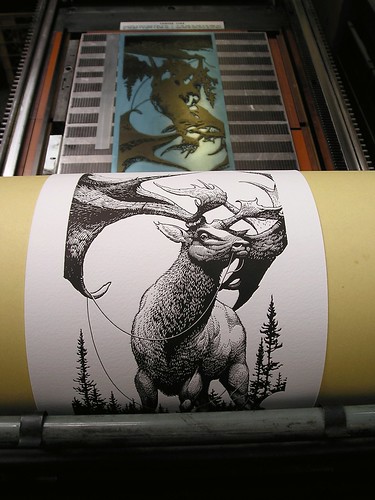
Megaloceros, Aaron Horkey, Dead Arts Publishing, 2010. Printing at The Bieler Press.
Gerald Lange of The Bieler Press printed with the photopolymer plate process since 1991 and provided plates for the contemporary studio letterpress community since 1995. Offered to letterpress printers were professionally processed premium-grade plates for today’s common bases. Information that follows was used by the Press when producing plates.
Photopolymer Plate Specifications:
Stocked were the following Toyobo Printight Type K brand plates for use with flatbases. These specific photopolymer plates are state-of-the-art industrial quality and meet the standard letterpress formulated hardness rating of Shore D 67˚. They are manufactured with photosensitive nylon resin, thus they hold sharp detail and fine lines exceptionally well with no loss of imaging during presswork.
• KM95GR—steel-backed at .038" thickness—highly recommended for use on production Vandercooks or Heidelbergs with properly configured magnetic base, e.g., an industry-standard Bunting Magnetic Cerface Flat Base ground to .880" (no interlay required). This was the plate used at The Bieler Press for all of its production (see pic above). It is especially recommended for large format pieces and/or difficult imaging. This plate can also be fitted to a Patmag base (or similar non-industrial economical base with magnetic top sheeting) with appropriate underlay (+/- .022) and interlay [such as 3M’s 75 Spray Adhesive].
• KM152GR—steel-backed at .060" thickness—specifically recommended for use on job platen presses, such as a C&P or Kluge, and smaller platens, where roller height issues may be of concern. The normal configuration for a Patmag base or fitted to a Bunting Magnetic Cerface Flat Base ground to .858".
• KF95GC—polyester-backed at .038" thickness—common configuration for economical non-industrial aluminum flatbases such as the Boxcar Base, the ēlum Eluminum, or others of similar non-magnetic construction. Plates include an attached .004" transparent film adhesive interlay [from BiesSse Tape Solutions]. Requires appropriate underlay if used on any flatbase measuring less than .875" +/-.
Maximum plate size (including required margins, crop marks, or other registration devices) is 16-1/2 by 23-3/8 inches (A2). Plates were furnished with unaligned edges cut approximately 1/4 to 3/8 of an inch (+/-) margin around imaging (if more or less edge border is required client should request this with order and provide adequate room on e-file).
Imaging and Film Negatives:
B/W line art furnished for platemaking must be in the form of high-quality imagesetter generated silver-based film negatives with discernible emulsion side, a resolution of 2400 dpi (highly recommended), and made as RREUs (right reading/emulsion side up). Select EPS or Press Quality PDF when submitting e-files to your film processor. For difficult imaging requiring dot patterns, such as photographs or tonal backgrounds, please inquire.
If the client requires multiple plates cut from negatives, imaging should be separated by a minimum of 3/4 of an inch and aligned for linear cuttings in either direction. Cutting schematic should be emailed via PDF or enclosed with a film negative. In all cases, to avoid problems please leave at least half an inch margin at outside edges of the film negative.
Negatives and all other materials are returned to the client with plates. Negatives are trimmed to facilitate platemaking.